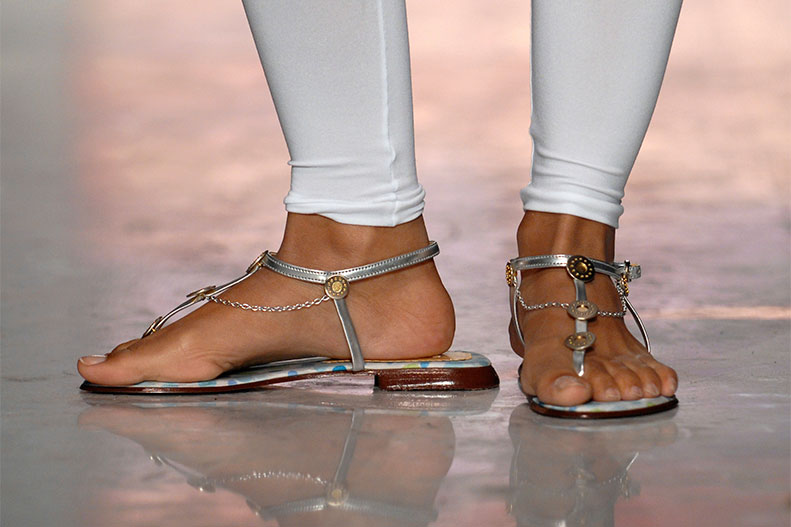Have you examined your feet lately? Specifically your toes? If you notice a toe that is bent or pointing at an odd angle, you may suffer from a hammer toe.
“Hammer toes are deformities in one of the four little toes of the foot,” explains orthopaedic surgeon Carl Hasselman, MD, of the UPMC Foot and Ankle Center. “Whereas normal toes look straight, hammer toes become flexed or curled. As they bend, they stick up at the middle knuckle of the toe, making the affected toe look like a hammer.”
Never Miss a Beat!
Subscribe to Our HealthBeat Newsletter!
Thank you for subscribing!
You can now select the specific newsletters you'd like to receive.
You are already subscribed.
Subscribe to more newsletters in our email preference center.
Sorry, an error occurred. Please try again later.
Get Healthy Tips Sent to Your Phone!
Hammer Toe Causes and Risk Factors
There are several causes of hammertoes, according to Dr. Hasselman, but mainly it has to do with what you wear on your feet.
“For women especially, ill-fitting shoes can cause an issue,” he says. “Your toes are being scrunched in the shoe. There’s not enough adequate space for them to move.”
Other common causes of hammer toe include:
- Diabetes
- Neuropathy
- Problems with the tendons in your toes
“Age, sex, and toe length can make certain individuals more susceptible of developing hammer toes,” says Dr. Hasselman.
Hammer Toe Symptoms
Besides their physical appearance, hammer toes are most often characterized by pain.
“As that knuckle rubs inside against the shoe, it’s going to hurt,” explains Dr. Hasselman. “Eventually, you will develop thicker skin in that area, which is what we call a corn or a callus. These are also painful.
“If left untreated over a long period, this rubbing can create a hole in your toe, which may lead to infection.”
Hammer Toe Diagnosis and Treatment
Hammer toes can be diagnosed visually during a physical exam. An x-ray may be ordered to rule out other possible or less common causes of the problem.
Once the diagnosis is made, Dr. Hasselman says the majority of hammer toes can be treated non-operatively. He starts treatment by counseling patients on appropriate shoe wear.
“I have my patients stand on a piece of paper and I’ll draw the outline of their foot without a shoe on,” he explains. “Then I’ll take their shoe and lay it over the area I just drew. It’s amazing how many times the toes aren’t actually covered by the shoes. This tells me you’re scrunching your toes.”
How to prevent hammer toe
To prevent hammer toes, Dr. Hasselman urges his patients to wear shoes with adequate room for the toes. For those who already have hammer toes, patients may be encouraged to use braces, orthotics, padding, or sleeves.
Hammer toe treatment without surgery
“Once you have developed a hammer toe, tennis shoes, or shoes with very soft leather are good to wear,” he says. “Avoid anything with a hard material on the top because they will not bend or give with the deformity.”
If nonsurgical treatment is unsuccessful, there are surgical options available.
Hammer toe correction surgery
“The surgery is designed to straighten the toe, so it lies flat when you are standing or walking,” Dr. Hasselman explains. “Sometimes I need to lengthen the ligament or tendon. Other times I need to remove part of the bone.
“These surgeries are done on an outpatient basis through small incisions. Most of the time, patients can walk with a post-operative shoe immediately. It’s definitely considered minor surgery if it needs to be done.”
Whether you have a new injury, or symptoms that include chronic foot pain, ankle pain, heel pain, swelling, or limited movement, our skilled foot and ankle surgeons offer comprehensive treatment options to help you find relief. To learn more, visit the UPMC Foot and Ankle Center online or call 844-ANKFOOT to make an appointment to speak with an expert.
About UPMC Orthopaedic Care
When you are dealing with bone, muscle, or joint pain, it can affect your daily life. UPMC Orthopaedic Care can help. As a national leader in advanced orthopaedic care, we diagnose and treat a full range of musculoskeletal disorders, from the acute and chronic to the common and complex. We provide access to UPMC’s vast network of support services for both surgical and nonsurgical treatments and a full continuum of care. Our multidisciplinary team of experts will work with you to develop the treatment plan that works best for you. Our care team uses the most innovative tools and techniques to provide better outcomes. We also are leaders in research and clinical trials, striving to find better ways to provide our patients care. With locations throughout our communities, you can find a provider near you.
